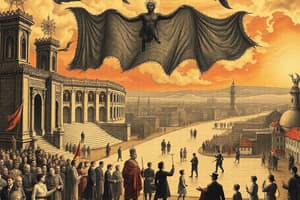Podcast
Questions and Answers
What was the purpose of the German flag carried by the peoples of Germany?
What was the purpose of the German flag carried by the peoples of Germany?
- To declare their allegiance to the Russian empire
- To symbolize their liberal hopes for unification (correct)
- To show support for the French revolution
- To represent their historical victories
What does the presence of Christ, saints, and angels symbolize in the image?
What does the presence of Christ, saints, and angels symbolize in the image?
- The decline of nationalism in Europe
- The dominance of religious power over political power
- Fraternity among the nations of the world (correct)
- The spread of atheism in society
What was the end result of the changes brought about by nationalism in Europe during the nineteenth century?
What was the end result of the changes brought about by nationalism in Europe during the nineteenth century?
- Emergence of the multi-national dynastic empires
- Creation of a modern nation-state (correct)
- Development of a centralized power without sovereign control
- Establishment of religious supremacy
What is the main characteristic of a nation-state?
What is the main characteristic of a nation-state?
When did the concept and practices of a modern state develop in Europe?
When did the concept and practices of a modern state develop in Europe?
According to Ernst Renan, what is the culmination of a nation?
According to Ernst Renan, what is the culmination of a nation?
What does Renan believe are the essential conditions of being a people?
What does Renan believe are the essential conditions of being a people?
What does Renan mean by 'daily plebiscite' in the context of a nation?
What does Renan mean by 'daily plebiscite' in the context of a nation?
According to Renan, why is the existence of nations a good thing?
According to Renan, why is the existence of nations a good thing?
What does Renan suggest is the right of the inhabitant of a province?
What does Renan suggest is the right of the inhabitant of a province?
Study Notes
Nationalism and Nation-State
- The German flag carried by the people of Germany symbolized the unity and solidarity of the German nation.
Symbolism in Imagery
- The presence of Christ, saints, and angels in an image symbolizes divine approval and blessing for the nationalist movement.
Nationalism in 19th Century Europe
- The end result of the changes brought about by nationalism in Europe during the 19th century was the reorganization of the continent into nation-states.
Characteristics of a Nation-State
- The main characteristic of a nation-state is that it is a sovereign state that derives its political legitimacy from the collective identity of its people, who are often ethnically and culturally homogeneous.
Development of Modern States
- The concept and practices of a modern state developed in Europe during the 18th and 19th centuries.
Ernst Renan's Concept of Nation
- According to Ernst Renan, the culmination of a nation is a sense of shared identity and heritage that is created and maintained through a shared history and common cultural practices.
Essential Conditions of Being a People
- Renan believes that the essential conditions of being a people are a shared language, common history, and a sense of solidarity.
Daily Plebiscite
- Renan's concept of 'daily plebiscite' refers to the constant, everyday affirmation of a nation's existence and identity by its people through their shared practices and collective identity.
Importance of Nations
- According to Renan, the existence of nations is a good thing because it provides a sense of belonging and identity to the people who make up the nation.
Rights of Inhabitants
- Renan suggests that the right of the inhabitant of a province is to have the freedom to decide whether to remain part of the existing nation or to form a new nation.
Studying That Suits You
Use AI to generate personalized quizzes and flashcards to suit your learning preferences.
Description
Test your knowledge about the symbolic representation of liberal hopes in 1848 depicted in Sorrieu's revolutionary tricolour painting, where various European peoples are shown with their flags, expressing aspirations for national unity.



